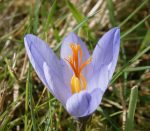 This perennial corm is native to areas from southern Turkey to southwest Syria but is found on rocky hillsides and open woods from North Africa to Palestine and Armenia. It is a member of the iris family, Iridaceae, that also includes gladiola, freesia, and crocosmia. The plant grows up to 4″ tall and has gray-green grass-like leaves. In the fall, slender stemless flowers appear with pale blue corolla marked with dark violet strips on the inside. Crocuses are especially attractive when planted in large numbers in beds and borders and are a good choice for rock gardens, gravel gardens, and containers. The genus name, Crocus, is from the Greek word κρόκος, krokos meaning thread and refers to the appearance of the stigmas. The specific epithet, cancellatus, is the Latin word meaning latticed, or cross-barred.
This perennial corm is native to areas from southern Turkey to southwest Syria but is found on rocky hillsides and open woods from North Africa to Palestine and Armenia. It is a member of the iris family, Iridaceae, that also includes gladiola, freesia, and crocosmia. The plant grows up to 4″ tall and has gray-green grass-like leaves. In the fall, slender stemless flowers appear with pale blue corolla marked with dark violet strips on the inside. Crocuses are especially attractive when planted in large numbers in beds and borders and are a good choice for rock gardens, gravel gardens, and containers. The genus name, Crocus, is from the Greek word κρόκος, krokos meaning thread and refers to the appearance of the stigmas. The specific epithet, cancellatus, is the Latin word meaning latticed, or cross-barred.
Type: Perennial corm
Bloom: Slender pale blue flower with purple stripes in fall
Size: 4″ H x 2″ W
Light:Full sun
Soil: Average, medium moist, well-drained
Hardiness: Zones 3-8
Care: Low maintenance
Pests and Diseases: Slugs, snails, mice, voles, corm scab, mosaic virus
Propagation: Seed, division
Companion Plants: Cyclamen, blue mist shrub, “Autumn Joy’ sedum
Photo Credit: Meneerke bloem Wikipedia